Human Flower Project
Birches at Pentecost
In the Orthodox Church, Holy Trinity (50 days after Easter) is draped with the greenery of birch boughs.
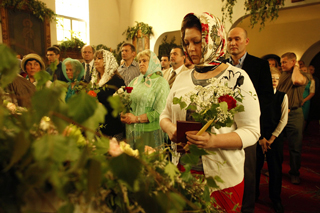
Pentecost 2012, at Saint Nicholas Russian Orthodox Cathedral, Seattle, Washington: the church is decorated with birch branches and flowers in observance of the Holy Spirit’s presence.
Photo: Erika Schultz/Seattle Times
In the Protestant denomination of our raising – the Episcopal Church – Pentecost meant an outpouring of red Sunday outfits and searing reference to the apostles’ “tongues of fire.” In the Eastern Orthodox faith, Pentecost – better known as Trinity Sunday – is green.
The Orthodox clergy wear green vestments shot through with golden threads, and churches are generously festooned with boughs of birch. Clusters of the spring leaves, heart shaped and serrated, stand in windows, adorn pulpits, and surround icons. In some parishes, stems of birch are scattered over the church floors, too. It’s as if the Holy Spirit descended not as fire but wind, shredding the trees outside and gusting them into the nave.
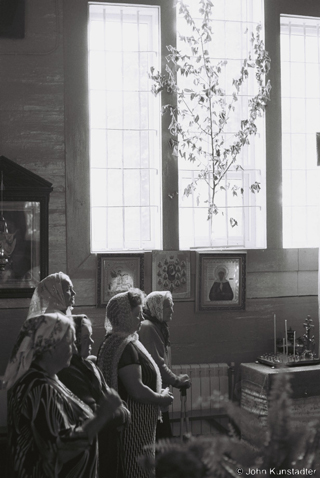 Name-Day feast at the Orthodox parish of Azdamichy-Tsjerablichy, June 14 in 2011, the Tuesday after Trinity Sunday.
Name-Day feast at the Orthodox parish of Azdamichy-Tsjerablichy, June 14 in 2011, the Tuesday after Trinity Sunday.
Photo: John Kunstadter
We were alerted to this practice of Orthodox Christianity by John Kunstadter’s awe-inspiring Radzima Photo, his exquisite chronicle of life in Belarus. John writes, “Placed throughout churches for Trinity, birch branches are a traditional Belarusian symbol of fertility and the life-giving power of the Holy Spirit.”
The branch in a high window, soft sunlight glowing beyond it, makes “spirit” fresh and demonstrative – a power both transcendent and everyday.
A Russian blogger explains, “The Feast of the Holy Trinity (or Holy Trinity Day) is celebrated through decoration. Villagers nail tree branches to their front porches and gates, transforming houses into fairy-tale-like wood dwellings. Indoors, the floors are covered with cut grass.”
According to this same commentator, the custom of decorating with tree branches at this point in the spring “comes from ancient Judaism, in which the Pentecost, the Feast of Harvest, was celebrated outside amongst the flourishing nature.” We welcome readers’ thoughts – or better, their information – about this theory.

The floor of Saint Nicholas Russian Orthodox Cathedral is covered with greenery for Pentecost.
Photo: Erika Schultz/Seattle Times
In the Ukraine, “Holy Trinity Day coincided with a series of Slavic pagan holidays called Zeleniye Svyatki, or ‘Green Christmastide,” which focussed on the worship of the “Spirits of Greenery.’” One of these holidays, Semik, was presided over by the birch in particular. “This explains why branches of the birch tree were frequently used to decorate houses and churches and why villagers liked to arrange dances [khorovody] around birch-trees.”
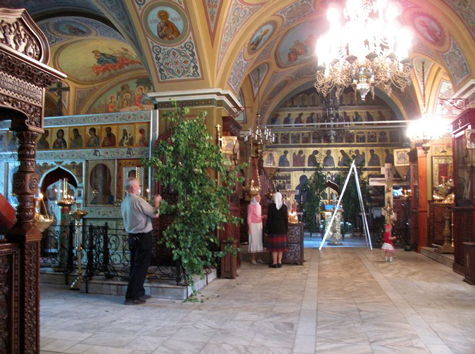
Decorating the Church of Nativity of the Blessed Virgin Mary in Old Simonov, Moscow.
Photo: Irina
Anthropologist Margaret Paxon undertook a full-fledged study of Trinity customs in Russia. She notes that the oldest traditions that incorporated pagan spring rites with Christian observance have been both watered down by modernity and contorted by Soviet politics. One of her more elderly sources reported, “On the holiday that was once Troitsa [Trinity], they would bring rows of beryozki branches into the clubhouse and girls would dance under them. They would recite poems and sing songs in praise of the birch tree. ‘Birches are good for the pochki (kidneys) and can clean dirty air,’ she added. There was a program for children on this holiday (with events like flower-naming contests) and in the later part of the evening adults would sing and dance.”
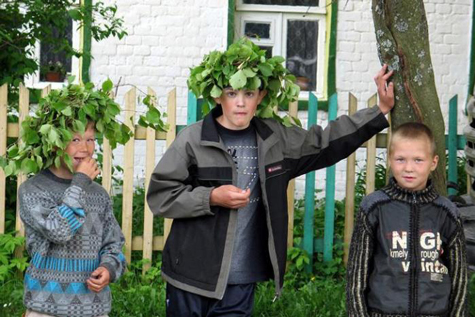
Russian boys in birch headgear
Photo: Lucky Lovers
Paxon concludes her study of rural customs, “The celebration of the birch tree was also pretty sterile. It was supposed to be a cheery paean to the Russian folk, and it managed to take some of the right elements (girls, birch trees, songs) but literally decontextualized them. Like the church before it, the Soviet state had rewritten the calendar and placed within it its own holy days: using the calendar as one of its demonstrations of ideological muscle. Interestingly, where the church had turned pagan holidays into religious ones, the Soviets had subsequently taken the religious holidays and made them into pagan ‘lite.’ The day of the birch tree could be very cute, with children reciting nature poems, but if, in fact, the pagan part this holiday was about fertility in June—just when the land is starting to feel the warmth of it powers—no play about the medicinal virtues of the birch tree would unleash this primal force. Any symbolic power these elements had seems to have gotten lost in the translation. In the past several years, with no one to plan ‘the day of the birch tree,’ the holiday shriveled up along with trips to the church. On the other hand, trips to the graveyard on this day, never stopped.”
While Paxon found that ritual greenery inside the church (and church going in general) had largely disappeared, people still took birch branches to cemeteries, turning Holy Trinity into something more like U.S. Decoration Day.
In the same vein, another Russian author writes, “The Slavic peoples have long [observed] the custom to plant a birch tree over the grave of the fallen soldiers—that their life went on in the earth’s tree. How many birch groves were planted after the Great Patriotic War!”
And which war was that?
“Birch trees rustle in Mamaev Kurgan in Volgograd, Minsk, in Leningrad – St. Petersburg, Moscow, Berlin’s Treptow Park…”
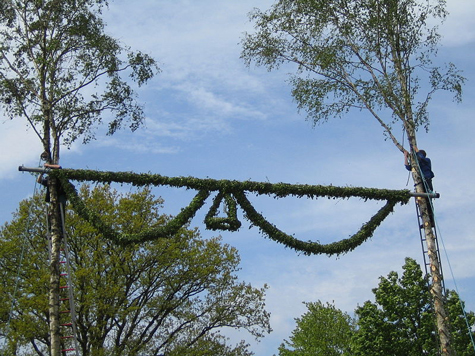
Das Pfingstbaumpflanzen: Pentacost trees
Photo: German Language Blog
Speaking of Germany, which is not known for its Orthodox faith, we found this reference to birches at Pentecost:
“Das Pfingstbaumpflanzen (The planting of the Pentecost Tree)
“In this custom usually birches are incorporated. For example, you attach a braided garland, made of leafs, between two birch trees. The actual Pentecost trees are fresh logged birch trees, which are usually put up in front of the front door. They are either dug in or are tied up to something.”
This account is confusing or maybe the translation’s just poor; we can’t tell if the birches are planted or cut down (logged) for the occasion. Maybe both.
Finally, we are thrilled to pass along Erika Schultz’s superb photo essay of Pentecost at Seattle’s Saint Nicholas Russian Orthodox Cathedral Sunday, June 3, 2012. Seattle’s a long way from Moscow, but birches grow well here in Washington, and the congregants clearly handle beryozka with exuberance, much in keeping with the Spirit.

